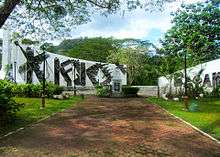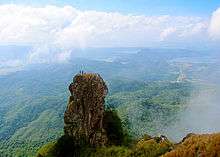Maragondon
| Maragondon | |
|---|---|
| Municipality | |
| Municipality of Maragondon | |
|
Municipal plaza | |
| Nickname(s): Historic Town & Wildlife Sanctuary | |
 Map of Cavite with Maragondon highlighted | |
.svg.png) Maragondon Location within the Philippines | |
| Coordinates: 14°16′N 120°44′E / 14.27°N 120.73°ECoordinates: 14°16′N 120°44′E / 14.27°N 120.73°E | |
| Country |
|
| Region | Calabarzon (Region IV-A) |
| Province | Cavite |
| District | 8th District |
| Founded | 1727 |
| Barangays | 27 (see Barangays) |
| Government [1] | |
| • Type | Sangguniang Bayan |
| • Mayor | Reynaldo Rillo |
| • Vice Mayor | Ireneo C. Angeles |
| • Electorate | 26,508 voters (2016) |
| Area [2] | |
| • Total | 164.61 km2 (63.56 sq mi) |
| Population (2015 census)[3] | |
| • Total | 37,720 |
| • Density | 230/km2 (590/sq mi) |
| Time zone | UTC+8 (PST) |
| ZIP code | 4112 |
| PSGC | 042113000 |
| IDD : area code | +63 (0)46 |
| Climate type | Tropical monsoon climate |
| Income class | 3rd municipal income class |
| Revenue (₱) | 101,388,428.87 (2016) |
| Native languages | Tagalog |
| Website |
www |
Maragondon, officially the Municipality of Maragondon, (Tagalog: Bayan ng Maragondon), is a 3rd class municipality in the province of Cavite, Philippines. According to the 2015 census, it has a population of 37,720 people.[3]
Barangays
Maragondon is politically subdivided into 27 barangays. [2]
- Bucal 1
- Bucal 2
- Bucal 3A
- Bucal 3B
- Bucal 4A
- Bucal 4B
- Caingin Pob.
- Garita 1A
- Garita 1B
- Layong Mabilog
- Mabato
- Pantihan 1 (Balayungan)
- Pantihan 2
- Pantihan 3 (Pook na Munti)
- Pantihan 4 (Pulo ni Sara)
- Sta. Mercedes (Patungan)
- Pinagsanhan A (Ibayo)
- Pinagsanhan B (Ibayo)
- Poblacion 1A
- Poblacion 1B
- Poblacion 2A
- Poblacion 2B
- San Miguel A (Caputatan)
- San Miguel B (Caputatan)
- Talipusngo
- Tulay Silangan (Mabacao)
- Tulay Kanluran (Mabacao)
History

The name Maragondon was derived from Tagalog word madagundong or maugong, meaning much sound. Actually the sounds come from a noisy river called Kay Albaran in the barrio of Capantayan. This area was the first townsite selected, but because the river frequently overflowed and flooded the place, the town was later relocated to its present site. The word madagundong not being pleasant to the ear, the people had it changed to marigundong in honor of the town's patron saint, Nuestra Señora de la Asunción (Our Lady of The Assumption).
Soon after the establishment of the American regime, Lope K. Santos, an authority on Tagalog language and member of a geographic committee created to "investigate and revise" the names of Philippine towns and provinces, recommended the change of Marigundong to "Maragondon" definitely more pleasing to the ear, the present name of the town
Incidentally, Maragondon has three foundation dates; namely, 1. ) 1611 when the Franciscan Fathers from Silang established their first visita or chapel; 2.) 1690, the Fundacion Ecclesiastica or founding of the regular parish by the Jesuits, dedicating it to Our Lady of the Assumption; 3.) 1727, the Fundacion Civil, when the original barrio of Maragondon was separated from Silang during the administration of the Recollects and converted into an independent municipality with Gregorio Silvestre as the first gobernadorcillo. Maragondon belonged to the corregimiento of Mariveles (now Bataan province) until 1754 when Spanish governor General Pedro Manuel de Arandia (1754 A- 1759) abolished the politico A- military administration and restored Maragondon Cavite Province.

In the second half of the 19th century the towns of Ternate, Magallanes, Bailen, Alfonso, and Naic were mere barrios of Maragondon. Ternate was separated from Maragondon on March 31, 1857, under an agreement signed by Tomas de Leon, Felix Nigosa, Pablo de Leon, Florencio Nino Franco and Juan Ramos in behalf of the people of Ternate.
Furthermore, Bailen (now Gen. Aguinaldo) and Alfonso seceded from Maragondon in 1858. Magallanes followed suit on July 15, 1879 under an agreement signed by Crisostomo Riel representing Maragondon, and by Isidro Bello and company representing Magallanes.
Maragondon played a significant role in the Philippine revolution. Although the town belonged to the jurisdiction of the Magdiwang Council, its brave sons like the three Riego de Dios brothers ( Emiliano, Vicente and Mariano), Esteban Infante, Crisostomo Riel, Vicente Somoza and Antero C. Reyes proved their unflinching loyalty to the Aguinaldo government.
All of them stuck to the revolution headed by Gen. Emilio Aguinaldo. Emiliano and Mariano Riego de Dios became top ranking generals; Vicente, a colonel, commanded the revolutionary troops as signed at Noveleta, the Magdiwang headquarters. Gen. Emiliano Riego de Dios was one of the three provincial governors of Cavite under the revolutionary government; and Mariano became the Taong Aguila (Eagle man) who saved Aguinaldo from certain death (threat?) in the battle of Naic. Gen. Mariano Riego de Dios, Colonel Crisostomo Riel and Colonel Esteban Infante were members of the council of war that tried and convicted the Bonifacio brothers (Andres and Procopio) of sedition and treason against the duly established the revolutionary government of Aguinaldo.
The Bonifacio brothers were sentenced to death by the council of war owing to their supposed counter revolutionary activities. Mariano Riego de Dios and Esteban Infante believed that the sentence was quiet harsh and abstained from signing the death verdict. Aguinaldo agreed with them and ordered commutation of the sentence from death to banishment to the mountain of Pico de Loro in Maragondon. Before this would happen, a few of the generals, including Gen. Mariano Noriel, thechairman of military court, and Gen. Pio del Pilar, had convincted Aguinaldo to withdraw the commutation sentence and carry out the original verdict.
ANOTHER VIEW--from the Veterans of the Magdiwang Faction of Maragondon, Cavite-- handed down few generations: Historic records failed to indicate that Bonifacio had a MOCK trial. He was ordered to be executed as he was hunted long before the said TRIAL at the Reyes Residence. The MOCKERY: His named Defender, Gen. Noriel, acted as his Prosecutor during the Mock Trial. At the time, Treason was allegedly a crime under the laws framed by the KKK under the leadership of Bonifacio, as the President of the Philippines. Here, Aguinaldo and the Magdalo Faction would be found guilty of Treason. Nonetheless, the Aguinaldo government, in the absence of an established legal document of any locally framed law by the Magdalo faction, in the MOCK TRIAL, they found that the Bonifacio brothers were guilty of Treason.
Without the benefit of the alleged Aguinaldo commutation, the seriously wounded Andrés Bonifacio was carried in a cradle across the River through the Riel Property by the river, now partly housing the contested Pob. 1B Barangay Hall and squatters area, while Procopio was required to walk to cross the river and march to the Execution location in Mt. Nagpatong, owned by Don Jose Reyes (Piping), brother of one-time Maragondon Governadorcillo Don Eduardo Reyes (Capitan Nining). Don Piping heard only one shot and was satisfied to find only one fallen Bonifacio to be buried in his land. To his disappointment, he was later informed that there were two brothers executed and Don Piping later surmised and concluded that the shot heard was for the missing Procopio while Andrés expired after multiple stabs by the executioner Macapagal.
The Magdiwang faction had for years maintained that Andrés was the First President of the Philippines while Aguinaldo was the First president of the First Philippine Republic. They maintained that Andrés Bonifacio was intelligent and highly educated, truly informed although lacking in certificates or diplomas for schooled individuals. Unfortunately, he was invited by cousin-in-law Gen. Mariano Alvarez to come to Cavite to try to unite the feuding Magdalo and the Magdiwang Factions to be better combatants for the cause of the KKK, ultimately to be executed by landed and highly aristocratic Cavite leaders who coveted his leadership of the KKK. Maybe the Manila Council under Mayor Estrada would succeed in according Bonifacio the respect and recognition he had long-time deserved as the First President of the Philippines, albeit, Revolutionary Government.
Historic records also failed to indicate that A. Bonifacio was the Supremo, the President of the Revolutionary Government that was recognized by the provinces that revolted against Spain. Thus, historic records also did not reflect that the Aguinaldo Government was not duly constituted at the time of the Bonifacio execution. At the time, some historical records from sources outside of Cavite indicated that the Revolutionary Government under Bonifacio had laws that could find the Aguinaldo movement treasonous. As it were, the Cavite movement with impunity, superseded the National Movement. The Aguinaldo Government held the MOCK trial and the execution of Gat Bonifacio.
Because the Filipino people failed to recognize the historic events surrounding the death of a National Hero, A. Bonifacio, they suffered from an unfortunate repeat of history when GMA like Aguinaldo, decided to become the President of the Philippines. Although with failure of due process, and with seeming complicity, the GMA Presidency was blessed by no less than Cardinal Sin. Similarly, the Aguinaldo (nom de guerre Magdalo) Presidency was blessed by Rev. Father Villafranca. Ironically, later, in Maragondon, the Magdalo faction would turn against the Roman Catholic Church and convert a Roman Catholic Chapel built on a borrowed and never returned private lot in 1900 to Aglipayan (IFI) Church in 1902.
Demographics
| Population census of Maragondon | ||
|---|---|---|
| Year | Pop. | ±% p.a. |
| 1903 | 7,191 | — |
| 1918 | 7,266 | +0.07% |
| 1939 | 9,449 | +1.26% |
| 1948 | 8,465 | −1.21% |
| 1960 | 9,994 | +1.39% |
| 1970 | 12,743 | +2.46% |
| 1975 | 14,785 | +3.03% |
| 1980 | 18,018 | +4.03% |
| 1990 | 22,814 | +2.39% |
| 1995 | 25,828 | +2.35% |
| 2000 | 31,227 | +4.15% |
| 2007 | 33,604 | +1.02% |
| 2010 | 35,289 | +1.80% |
| 2015 | 37,720 | +1.28% |
| Source: Philippine Statistics Authority[3][4][5][6] | ||
In the 2015 census, the population of Maragondon was 37,720 people,[3] with a density of 230 inhabitants per square kilometre or 600 inhabitants per square mile.
Images
- Our Lady of the Assumption Parish Church
- Welcome arch
- Barangay Poblacion 1-B
- Public market
- Bonifacio Trial House
 Mt. Pico De Loro Monolith
Mt. Pico De Loro Monolith Silyang Bato of Mt. Marami
Silyang Bato of Mt. Marami
References
- ↑ "Municipality". Quezon City, Philippines: Department of the Interior and Local Government. Retrieved 31 May 2013.
- 1 2 "Province: Cavite". PSGC Interactive. Quezon City, Philippines: Philippine Statistics Authority. Retrieved 12 November 2016.
- 1 2 3 4 Census of Population (2015). "Region IV-A (Calabarzon)". Total Population by Province, City, Municipality and Barangay. PSA. Retrieved 20 June 2016.
- ↑ Census of Population and Housing (2010). "Region IV-A (Calabarzon)". Total Population by Province, City, Municipality and Barangay. NSO. Retrieved 29 June 2016.
- ↑ Censuses of Population (1903–2007). "Region IV-A (Calabarzon)". Table 1. Population Enumerated in Various Censuses by Province/Highly Urbanized City: 1903 to 2007. NSO.
- ↑ "Province of Cavite". Municipality Population Data. Local Water Utilities Administration Research Division. Retrieved 17 December 2016.
External links
| Wikimedia Commons has media related to Maragondon. |